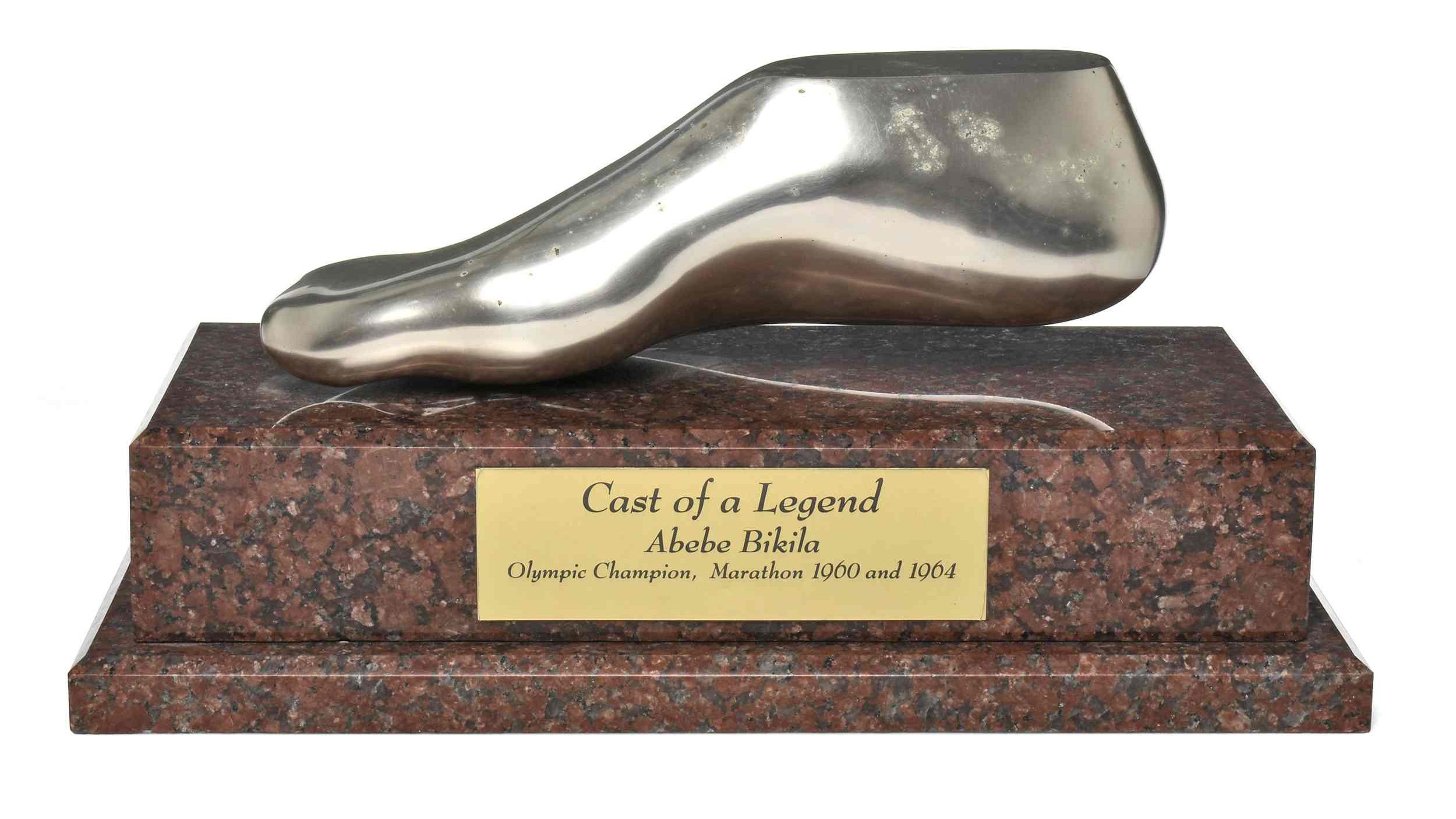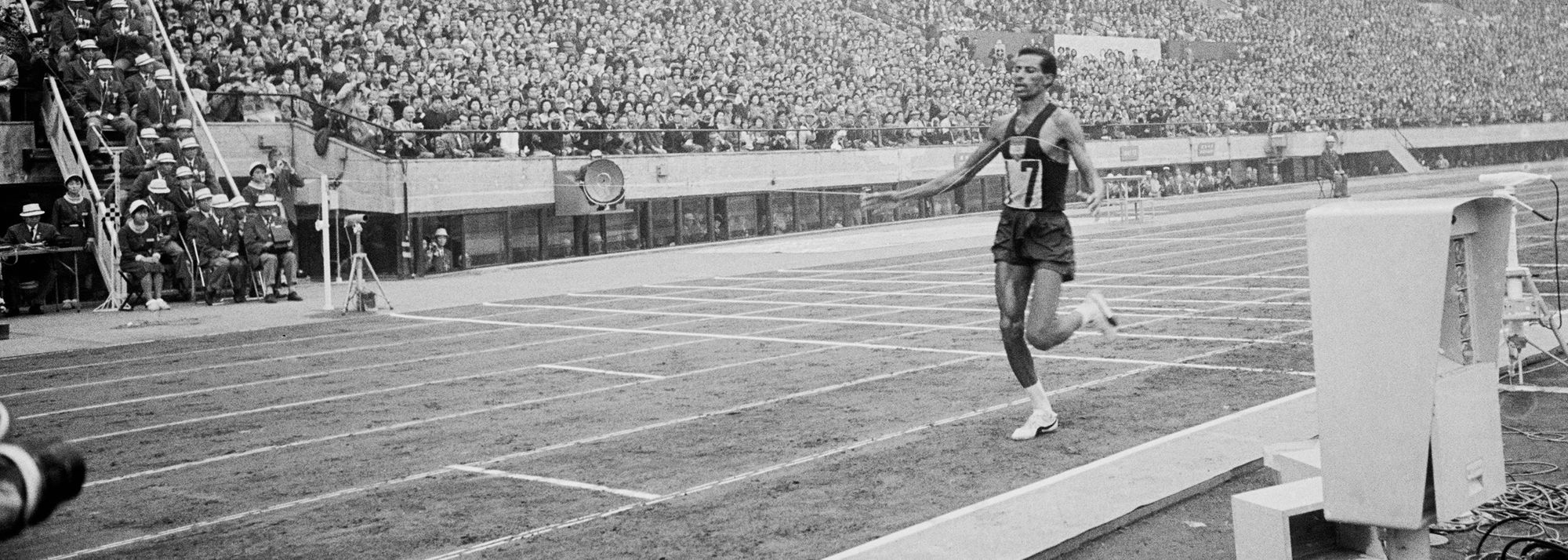Abebe Bikila wins his second Olympic marathon title in Tokyo in 1964 (© Getty Images)
When the celebrated movie director John Schlesinger came to formulate the opening sequence for Marathon Man, the classic thriller featuring Dustin Hoffman in the title role, he chose to use footage of Abebe Bikila from the official film of the 1964 Olympic Games.
It is not difficult to see why.
Watching Bikila in Kon Ichikawa’s highly acclaimed, highly evocative Tokyo Olympiad is as mesmerising an experience today as it was when the enigmatic Ethiopian ghosted serenely through the streets of the Japanese capital and into the annals of athletics history 60 years ago.
A member of Emperor Haile Selassie’s Imperial Bodyguard, Bikila had already secured a landmark achievement with his stunning barefooted marathon success in Rome in 1960, opening the floodgates as the first Olympic gold medal winner from the distance running hotbed of East Africa.
A metal cast of Bikila’s right foot, which was measured in 1961 when the Ethiopian visited Japan to participate in the Mainichi Marathon – a race he won in 2:29:27, will be inducted into the Museum of World Athletics (MOWA) in December.

A metal cast of Abebe Bikila's right foot (© MOWA)
The compelling close-up and slow-motion shots of Bikila on his way to becoming the first back-to-back Olympic marathon champion show a timeless figure, running with ease and grace, and with a smoothness of stride reminiscent of Kenenisa Bekele, one of the regal Ethiopians who followed the pioneering African king of distance runners.
There is not the slightest trace of distress on Bikila’s face as he eases clear of the plucky Irish athlete Jim Hogan and the Australian world record machine Ron Clarke and into the splendid isolation of what he truly was: a marathon man apart.
Just 40 days earlier, Bikila had undergone an appendectomy. For that reason, he was not expected to repeat his Roman heroics.
Wearing shoes this time, Bikila held back while Clarke – bronze medallist in the 10,000m a week before – blasted through the opening 5km in 15:06.
He pulled ahead from just before the halfway mark and finished a staggering 4 minutes 7 seconds clear of the field in 2:12:11.2 - shattering the 2:13:55 world record held by Basil Heatley, the British runner who proceeded to dramatically outsprint Japan’s Kokichi Tsuburaya for the silver medal.
Waving away the offer of a blanket after crossing the line, the unruffled Bikila calmly walked on to the infield to entertain the rapturous 75,000 crowd with a prolonged display of calisthenics.
Mel Watman characteristically nailed it in his race report for Athletics Weekly.
“Watching Bikila Abebe [sic] during the race was an almost mystical experience,” the great British athletics writer observed.
“How can a man reel off 26 miles in 5:02 apiece and seemingly remain as fresh and composed as when he started out?
“The rest of the world’s distance runners would dearly like to know.”
Despite his groundbreaking victory in Rome four years previously, in what was then a world record time of 2:15:16.2, Bikila was still such a mystical figure to the wider athletics world that his name continued to be written the wrong way round, not just in reports but in official results.
“I do not fear anyone”
In 1965, John Usherwood travelled to Addis Ababa in search of the marathon man behind the mystique for Sports Illustrated. He confessed to being taken aback when the double Olympic champion returned from a two-hour morning run in a state of perspiration.
“Watching his post-marathon repertoire of exercises in Tokyo, I imagined that he probably did not sweat, did not breathe hard, did not have a pulse,” Usherwood wrote.
The US sportswriter also discovered that Bikila had not been naturally blessed with his silkily-smooth running style.
It had been refined by the Finnish-born Swedish coach behind Bikila’s success.

Abebe Bikila on his way to marathon victory in Tokyo (© Getty Images)
Onni Niskanen was a major in the Swedish army, seconded to the Ethiopian military services as an advisor then as director of physical education.
A distance runner himself, selected to represent Sweden in the ultimately cancelled Alternative People’s Olympics in Barcelona in 1936, Niskanen nurtured Bikila on a diet of interval sessions and twice-weekly two hour runs in the hills and mountains outside Addis.
“Before 1959, I hardly knew who this Abebe was,” Niskanen told Usherwood. “He ran only third in the marathon trials for the Rome Olympics and already then he was 27 years old.
“At the beginning we had much trouble. He did not hold his head properly, his arms flew all over, his balance was bad. I had to keep yelling at him to convince him.
“But the dedication, the willpower of this man…there is none like him I have ever seen. He always expects to win.
“He does not even know who he is racing against. Clarke, Heatley, Edelen? They are just names to him.”
Bikila concurred. “I do not fear anyone,” he said. “I do not have to know the names and the faces of those I will exceed.”
“Laid down in my destiny”
One notable exception was Mamo Wolde. Bikila recognised and respected but did not fear his fellow guard and training partner, who finished fourth in the Olympic 10,000m in Tokyo.
As fate dictated, Wolde succeeded Bikila as Olympic marathon champion in Mexico City in 1968. Bikila dropped out after 17 miles, suffering from a fractured fibula.
The year after that he sustained spinal injuries in a car accident that left him paralysed from the waist down.
While receiving medical treatment in England in 1970, he competed in archery and table tennis at the Stoke Mandeville Games, the early predecessor of the Paralympics.
Bikila accepted his fate stoically, observing in 1971: “It was laid down in my destiny that at a certain moment I would be a famous athlete and that at a certain moment I would be as you find me now. It is God’s will.”
The great Ethiopian emperor of the marathon died of a brain haemorrhage in Addis Ababa in 1973. He was just 41.
Simon Turnbull for World Athletics Heritage





